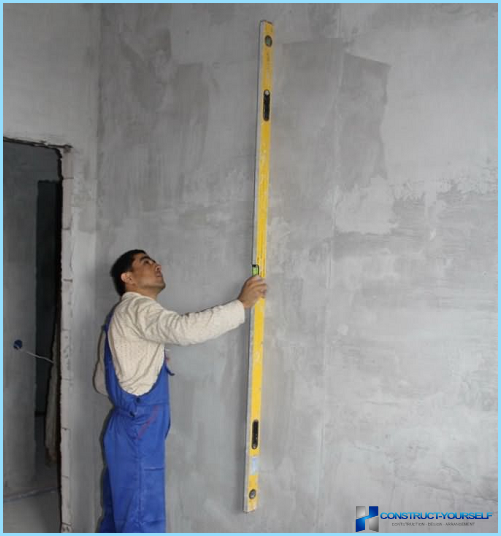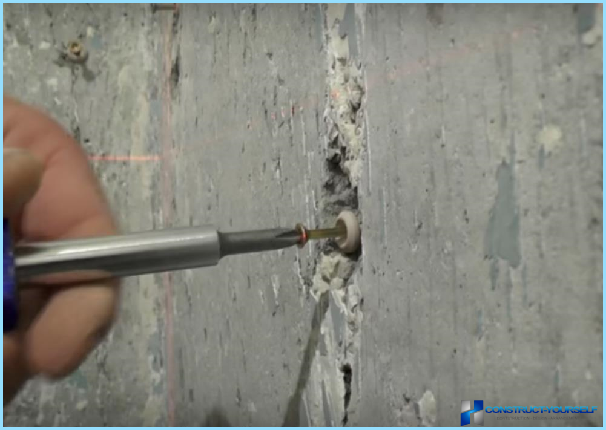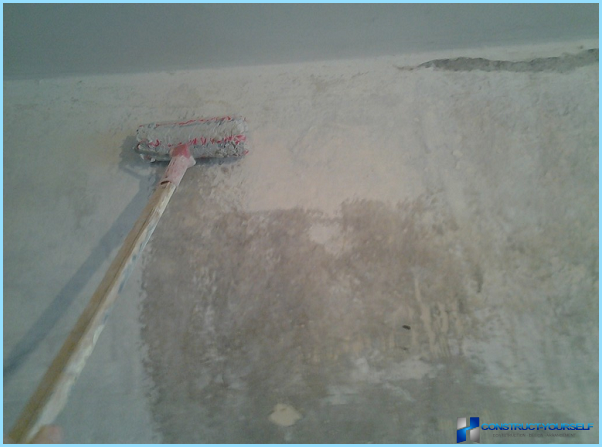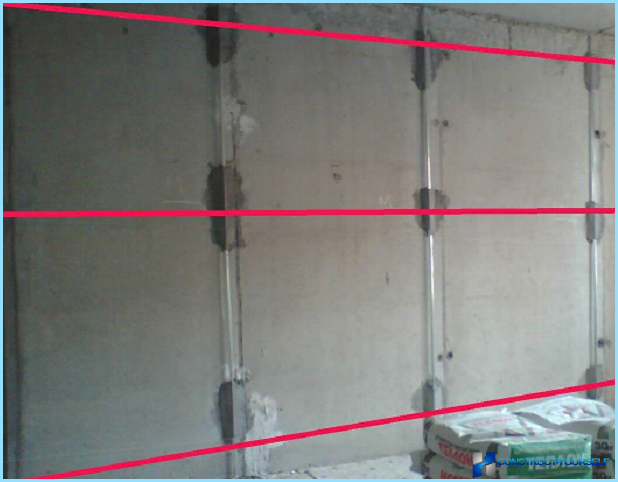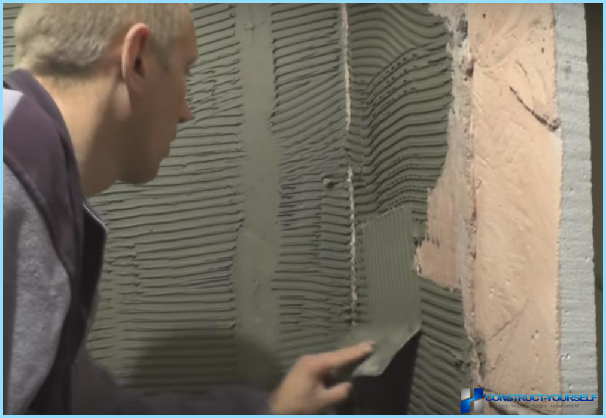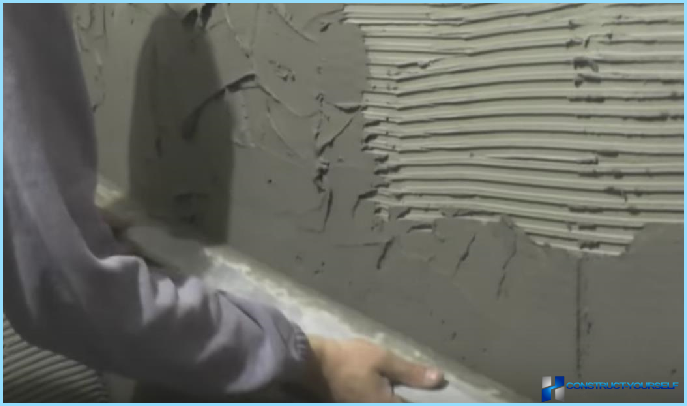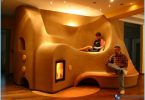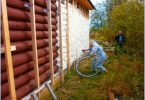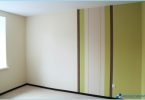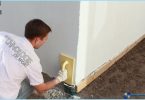The contents
- What is the difference between plaster, brick and concrete walls
- Plaster your own hands the walls of concrete and sand-lime stone
- Plasterer? with your hands on a concrete wall
- Features of the use of reinforcement mesh and profiles for angles
- Plaster walls of ceramic bricks with their hands
They say that the repair can only begin, to finish it it is impossible, therefore plastering work will always be in demand, regardless of the time of year and condition of the building. Multiple tips and expert advice is often contradictory and obscure. The technique of the plaster walls with their hands not as complicated as it may seem. It is better to see once than read a hundred times, so if you have plaster walls with their hands, the video will give a lot of sensible advice on technique.
What is the difference between plaster, brick and concrete walls ↑
Theoretically, working with plaster, brick and concrete surfaces are similar, but there are a few small but important differences:
- If you look closely at the surface of the ceramic brick and concrete surfaces, you can see that the first looks like microcube that easily absorbs solution and tenaciously holds the layer of plaster;
- The concrete surface is very dense and poorly fixed in the grip with cement or sand-cement plaster ground;
- The rate of drying of the solution on the concrete wall is significantly lower than a brick wall, and so the first frozen layer of plaster can simply be split off prior to the drying of the contact layer.
Plaster your own hands the walls of concrete and sand-lime stone ↑
The initial step in applying the plaster of all the walls is their measurement, verification of withdrawal of masonry or breach geometry. It is necessary, first of all, for optimal placement of beacons or landmarks, which runs the alignment layer of plaster, even to concrete walls, even brick. Under the point of placement of beacons choose vertical lines, separated by 10-15cm from the corners, at the same distance from the edge of the wall and several beacon profiles posted on the wall plane. The distance between the profiles should be 20-25cm less than the length of the rules. The size of the latter is already selected on the basis of the size of the room.
Outdoors you can work with his hands and a long tool, and inside is enough meter length.
Plasterer? with your hands on a concrete wall ↑
Primarily on the surface of the concrete walls apply small cutting Mat 8-10mm deep, it’s better to do with their hands with the gun, as the procedure is physically difficult, and when large areas of walls can take a long time. Carefully check the geometry and condition of the corners in okolomatocnah areas of the wall.
The sequence of applying the plaster with their hands on the concrete wall:
- With a punch to break into the field of the future the profiles of the lighthouses are the holes in the tube and screw the screws.
- Covered concrete wall primer layer and carefully dry the surface.
- Apply the wall adhesive for tiles and fasten the profile of lighthouses, landmarks.
?
The profiles themselves gloss over the mortar to give hardness and resistance to the surface was a thin reference strip, which will slide rule. After drying of the adhesive composition turn to the application of plaster mass
- Bred finished sand-cement plaster mix and gently do it on the wall. Due to the good adhesion of the adhesive to the concrete wall plaster is held freely on a vertical surface even at a layer thickness of 20-30mm;
- Rule smoothes the bulk of the plaster in the corners and ceiling of the wall, as in the video
- After 3-4 hours after the plaster has ceased to adhere to the fingers, but not completely dried out, fill a wooden spatula the most rough and uneven places.
Dry plaster in the room, depending on air temperature and humidity, up to three days.
Features of the use of reinforcement mesh and profiles for corners ↑
Often mesh for reinforcement of the plaster layer is used for both exterior and for interior walls. When you select the mesh, give preference to a fused and more rigid version, this will improve grip with plaster solution and guaranteed to prevent delamination of plaster.
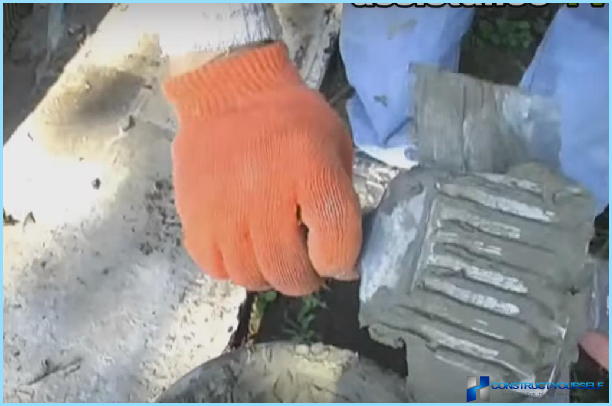
For fixing the grid on a brick or concrete surface is most often used adhesive composition based on cement and polymer additives. The consistency is creamy. It gently with your hands applied with a notched trowel to the prepared surface, a layer at a thickness of 7-8mm. In the corners the amount of mineral glue to enhance the installation of plastic angular profile.
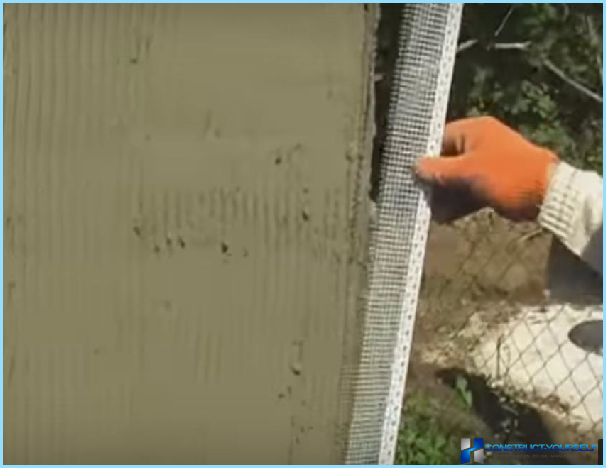
Such material is easy to cut your hands with scissors, and after the correction of the size is fixed at an angle on top of the applied layer of mineral glue.
Before final trowelling the edges of the area with the adhesive-profile position is governed by its own hand relative to the rib angle at the building level. Side shelf corners are sealed with an adhesive solution. Similarly, stronger internal corners.
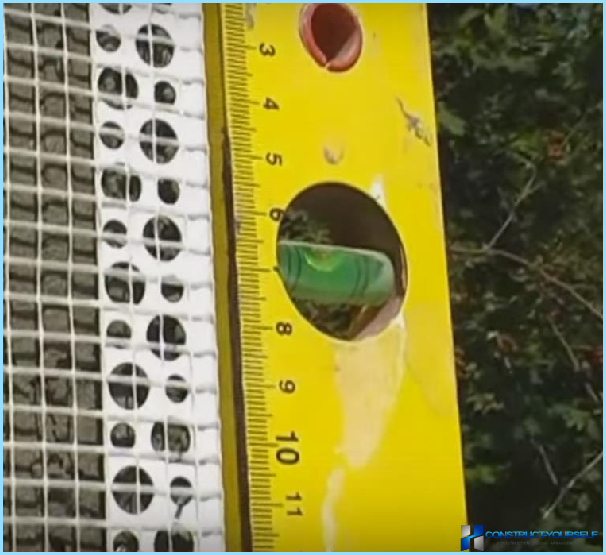
Smeared on the surface of the side corner shelf arms attach and align the edge of the reinforcing mesh. After clarifying the situation the lower edge of the cut, and the fabric gently clap trowel to the primed surface.
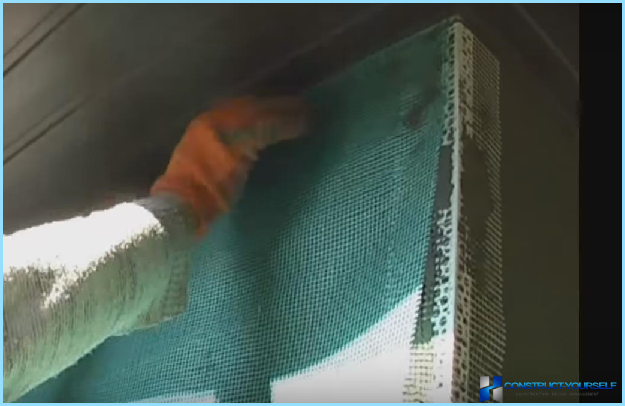
The rest of the plaster is applied with their hands on the side of the shelf angles, and all the cloth meshes sequentially overwritten the original composition. The thickness of the layer is governed by the requirements in the configuration of the plaster. If necessary, the above adhesive composition is applied with conventional plaster and consistently polished wood float.
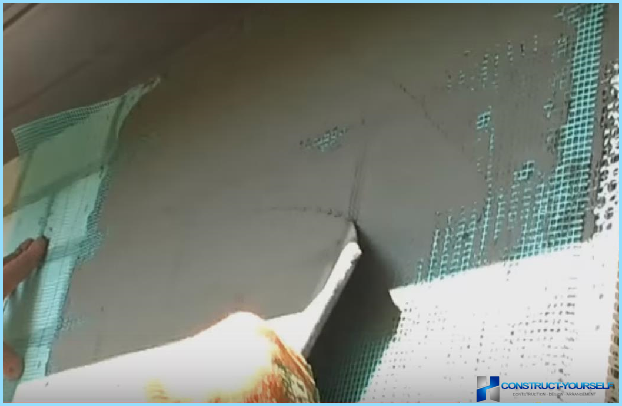
Plaster walls of ceramic bricks with their hands ↑
As in the case of concrete walls, the first step in the plastering, red brick is always the correct installation of the profiles of the beacons. To do this, along the wall, between the dowels, hammered in the corners, pull some thread or fishing line, which establish vertical profiles of the beacons. Most often, the beacons attached to the wall surface alabaster ground – it’s faster and more convenient. The distance between the profiles is slightly less than the length of the rules.
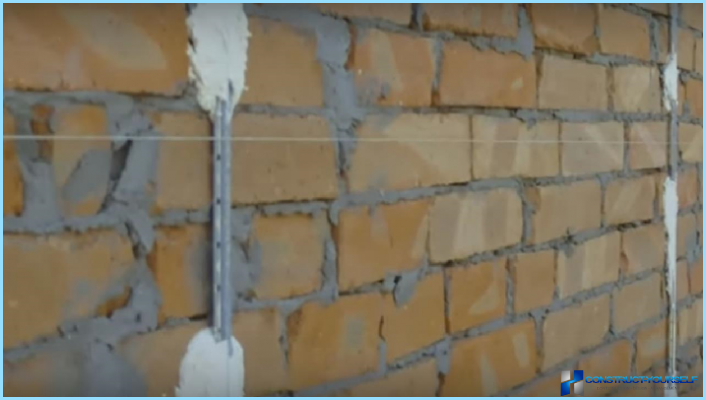
The first operation is wetting of the wall and applying the liquid plaster – spraying. Summer should be watered abundantly the brick wall, in the cold wet weather in the summer or fall you can do a little spatter brush.
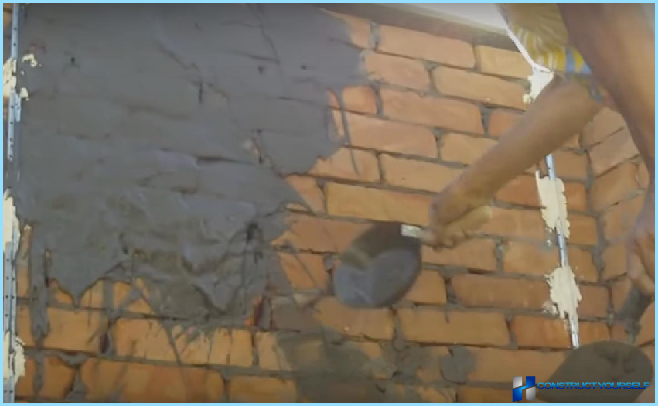
The consistency of the solution – a liquid cream. The composition applied with a bucket or similar dishes, evenly distributing the solution on the wall. The technique is easy to understand from the video
The spray adheres well to brick if you do it correctly, its thickness does not exceed 10 mm. At the completion of the first stage the thickness of the preliminary layer check with your hands on the gap between the rule and plaster. The first layer let dry until tack-free and the second layer that is already thicker. It dries and cures faster, so by applying a layer of periodically undergo the rule, thereby regulating the plane and the thickness of the plaster.
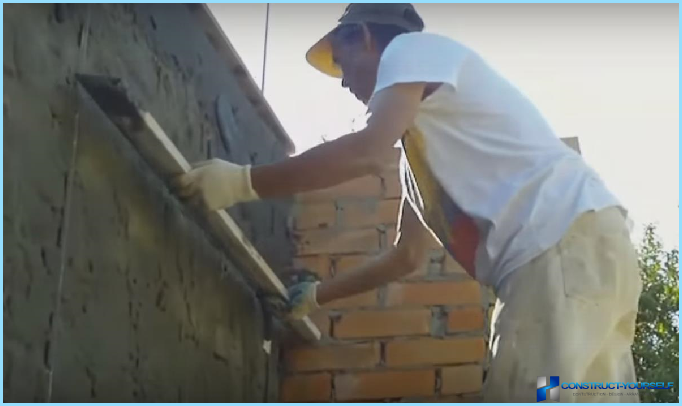
In an hour you can remove the profile of lighthouses, gently pry up the plank with a trowel or pointed tool formed vertical grooves are simply filled with mortar and trowelled to a level base layer of plaster. If this is not done, the profile will rust and destroy the wall.
The final step is to grout. Before the grout with your hands eliminate the flaws in the plaster layer, after several hours of drying the plaster start to finish the grinding.
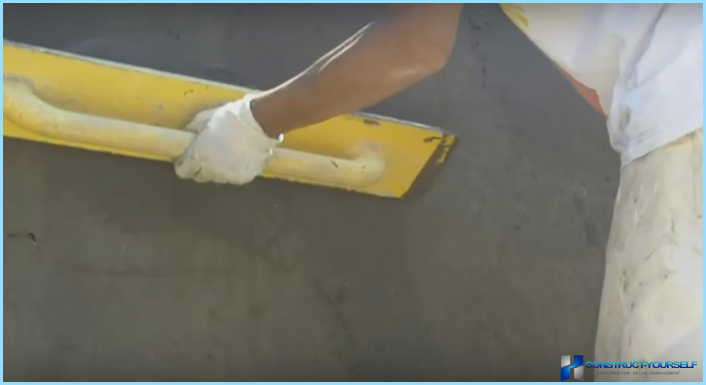
On the surface of the plaster with a brush, sprayed a small amount of water and immediately wet plaster trowel handle.
Therefore, in the hot season fresh layers periodically moistened with water spray with a brush or sprayer.
Conclusion ↑
The technique of applying the plaster for walls made of concrete and bricks largely similar, there are differences in some details the preparation of walls for plaster. Therefore, to get the first skill of your own hands with internal plasters, you can safely proceed to any of the options of external finishes.

